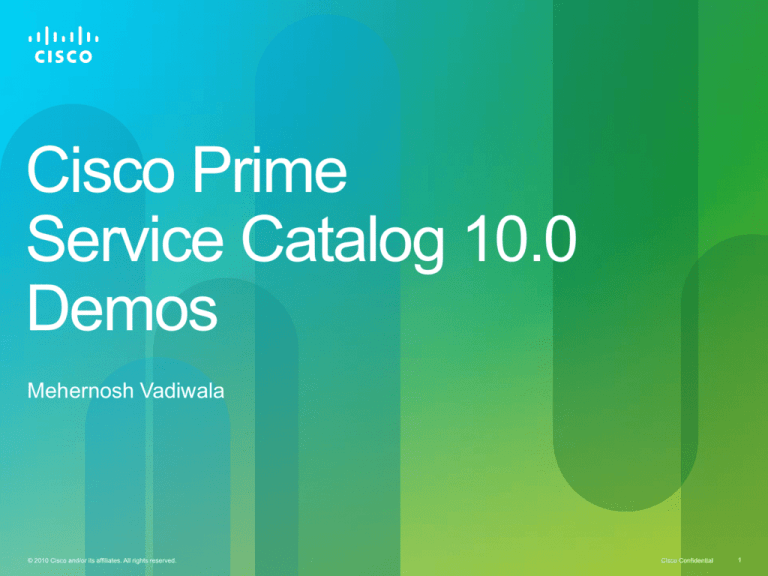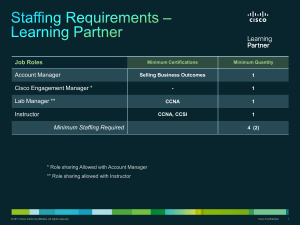
Cisco Prime
Service Catalog 10.0
Demos
Mehernosh Vadiwala
© 2010 Cisco and/or its affiliates. All rights reserved.
Cisco Confidential
1
• Service Item Status
• Service Item Operations
• Billing
• Accounts
• Capacity Management
• Quota Management
• Agreements
• Policies
© 2010 Cisco and/or its affiliates. All rights reserved.
Cisco Confidential
2
• Provide status as an Out-of-box attribute.
• Pre-define list of statuses allowed for a Service Item
• Control which related services can be ordered based on service
item status.
• Automatic ‘takeover’ of existing “Status” attribute.
• Automatic enforcement of valid status during SI updates
• Automatic enforcement status transitions during SI updates
© 2010 Cisco and/or its affiliates. All rights reserved.
Cisco Confidential
3
• Provide the ability to have “Named” Operations.
• Ability to specify a resultant “Status” for an operation that will be
updated automatically when the Service Item Task is executed.
• Ability to denote an operation as “Billable”
© 2010 Cisco and/or its affiliates. All rights reserved.
Cisco Confidential
4
High Level Use case:
• Designer would like to control that when a service is being
performed on a service item, no other service that impacts that
same service item can be ordered.
This use case is also known as “Service Item Locking”
Example:
• When the “Increase Disk size of a VM” service is executing for a
“Virtual Machine” no other related services, viz. “Start VM” or “Stop
VM”, can be ordered.
© 2010 Cisco and/or its affiliates. All rights reserved.
Cisco Confidential
5
Steps:
• Enable “Has Status” for Service Item “Virtual Machine”
• Add custom statuses “Active”, “Being reconfigured”,
“Reconfiguration complete”, “Inactive”
• Add the following state transitions for the above statuses
• “Active” -> “Being reconfigured” or “Inactive” or “Active”
• “Being Reconfigured” -> “Reconfiguration complete”
• “Reconfiguration complete” –> “Active” or “Inactive”
• “Inactive” -> “Active”
• Enable order of services only when the status is “Active”
© 2010 Cisco and/or its affiliates. All rights reserved.
Cisco Confidential
6
• Enable “Has Status” for Service Item “Virtual Machine”
• Add custom statuses “Active”, “Being reconfigured”,
“Reconfiguration complete”, “Inactive”
• Add the following “named” operations with their resultant statuses
• “Save Snapshot” -> “Being reconfigured”
• “Complete reconfiguration” -> “Reconfiguration complete”
• “Start” –> “Active”
• “Stop” -> “Active”
© 2010 Cisco and/or its affiliates. All rights reserved.
Cisco Confidential
7
Use case:
Automatic take over of existing status attribute when the “Has status”
checkbox is enabled.
© 2010 Cisco and/or its affiliates. All rights reserved.
Cisco Confidential
8
• Ability to specify billing rates for a service item based.
• Multiple Rate tables can be grouped into a Rate Group.
• Rate table has “Billing attributes” and “Lookup attributes”
• Rates for SI are defined for different values of “Billing attributes”
• Separate Rate tables can be defined for different SI Operations.
• During SI update, billing rate for a SI is automatically arrived at by
the application using the rate tables
• Writes to new table – SiBillingHistory
© 2010 Cisco and/or its affiliates. All rights reserved.
Cisco Confidential
9
What is Account ?
Account is the top level object against which “Quotas” are assigned and
tracked.
Accounts are of 2 types:
• Tenant Account
This account has 1-to-1 relationship with one OU. This OU is usually
the top level OU that hierarchical structure of sub-OUs. A Tenant
Account is created when quota needs to be tracked for a complete
OU hierarchy
• Project Account
This is a grouping of OUs. A Project account is created when quota
needs to be tracked collectively for a group of OUs that may or may
not have relationship with each other.
© 2010 Cisco and/or its affiliates. All rights reserved.
Cisco Confidential
10
• Ability to add custom attributes to the Account definition
• Specify values for Account specific functional positions
• Associate a Tenant account to an OU
• Associate a Project account to multiple OUs.
© 2010 Cisco and/or its affiliates. All rights reserved.
Cisco Confidential
11
• Built in infrastructure to track ‘Capacity’ of Service Provider.
• ‘Capacity’ is defined as the amount of resources that the Service
Provider has to fulfill his customer needs.
• For example. If an entity provides ‘Storage as a Service’ then the
total physical capacity in terms of GB will be the capacity of the
Service Provider
• The application can be configured to manage capacity
automatically by setting the ‘Managed By’ flag on the
corresponding service item attribute to ‘Capacity’
© 2010 Cisco and/or its affiliates. All rights reserved.
Cisco Confidential
12
• Built in infrastructure to track customer (account) consumption of
resources against an Agreement.
• For example. Assume a Service Provider provides ‘Storage as a
Service’ and a customer enters into an agreement with the service
provider to get ‘X’ GB of storage. If Quota Management is turned
on, then the application will track resource allocations (Quota)
automatically for the customer against the agreement.
• The application can be configured to manage quota automatically
by setting the ‘Managed By’ flag on the corresponding service item
attribute to ‘Quota’
© 2010 Cisco and/or its affiliates. All rights reserved.
Cisco Confidential
13
• Agreements are created for Accounts and are used to specify to
the maximum quotas of Service Items.
• Agreements are created off Agreement templates to promote lower
TCO
• Only attributes marked as “Quota” managed can be used to create
Agreements
• Sub-agreements can be created off agreements to address real life
situations where a customer (tenant) would like to distribute his
quota for SI across his sub-OUs
© 2010 Cisco and/or its affiliates. All rights reserved.
Cisco Confidential
14
Example:
• Create an Offering (Agreement Template) that includes 100 VMs
and 1 TB of storage
• Create an agreement based of this offering for “Cisco” Account.
• Create sub-Agreements based of the above agreement to
distribute the above quotas across the sub-OUs of Cisco.
© 2010 Cisco and/or its affiliates. All rights reserved.
Cisco Confidential
15
• The following policy types are supported
•
•
•
•
Capacity
Quota
Time bound
Event based
• The policy framework built is extensible and new Policy Types can be
easily added.
• Policy Type has one or more Policy templates.
• Policy Templates are parameterized per-defined conditions.
• Policy is an instance of a Policy Template with the parameters
replaced with actual values
• If a policy’s condition is satisfied then one or more user defined
actions are performed.
© 2010 Cisco and/or its affiliates. All rights reserved.
Cisco Confidential
16
CCP 10.0 contains the following set of OOB Policy templates
• Capacity
• Perform action with capacity threshold is reached
The policy is applied when "Item Attribute" reaches "Capacity Threshold"% of
maximum value.
• Quota
• Perform action when quota threshold for attribute is reached
The policy is applied for "Account" when "Item Attribute" reaches "Quota
Threshold"% of the account quota.
• Perform action when quota threshold for service item count is reached
The policy is applied for "Account" when service item count reaches "Quota
Threshold"% of the account quota.
© 2010 Cisco and/or its affiliates. All rights reserved.
Cisco Confidential
17
• Time bound
• Perform action when system date is equal to attribute value
The policy is applied when "Item Attribute" is equal to system date
• Perform action when system date is equal to attribute value +/duration
The policy is applied when "Item Attribute" is equal to system date"( +/- )"
"Hours".
• Event based
• Perform action when attribute is modified
The policy is applied when the value of "Item Attribute" is modified
• Perform action when attribute is set to a specific value
The policy is applied when the value of "Item Attribute" is set to "Value".
© 2010 Cisco and/or its affiliates. All rights reserved.
Cisco Confidential
18
CCP 10.0 contains the following set of OOB Policy actions
• Stop Submission
This action causes prevents the order from being submitted and/or service item
from being updated.
• Send Email
This action sends email as per the email template selected.
• Order Service
This action causes a pre-defined service request to be submitted. The service
form fields can be preset using literal values or “namespaces”
• Policy Alert
This action creates an entry in the policy alert log. The log text is preset and may
included “namespace” placeholders
© 2010 Cisco and/or its affiliates. All rights reserved.
Cisco Confidential
19
Capacity
• Create policy that would trigger an email when the “Capacity” of “Storage Area
Network” reaches 80% of the maximum capacity
Quota
• Create policy that would trigger an email when the count of “Virtual Machine”
for an account reaches 70% of the quota
• Create policy that would trigger order a service when the “Storage” of “Virtual
Disk” for an account reaches 75% of the quota
Time based
• Create policy that would trigger an email when the “Lease Expiration date” of
“Virtual Machine” is within X days of the system date
Event based
• Create policy that would trigger a policy alert when the “Status” of “Virtual
Machine” becomes “Offline”
© 2010 Cisco and/or its affiliates. All rights reserved.
Cisco Confidential
20



